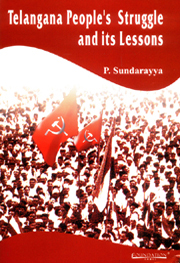Book contents
- Frontmatter
- Contents
- Preface
- Introduction
- PART I
- PART II
- 1 Entry of Indian Army and Immediately After
- 2 Terror Regime and Resistance
- 3 The Krishna Forest (Nallamala) Region
- 4 The Godavari Forest Region
- 5 Actions of Guerrilla Squads
- 6 People's Upsurge in Karimnagar and other New Areas
- 7 Movement in Cities and of the Working Class
- 8 Struggle Inside Jails
- 9 Women in the Telangana Movement
- 10 Brief Sketches of Some of the Squad and Party Leaders: after the Entry of the Indian Army
- 11 Withdrawal of Telangana Armed Partisan Resistance
- Epilogue
- PART III
9 - Women in the Telangana Movement
from PART II
Published online by Cambridge University Press: 05 November 2011
- Frontmatter
- Contents
- Preface
- Introduction
- PART I
- PART II
- 1 Entry of Indian Army and Immediately After
- 2 Terror Regime and Resistance
- 3 The Krishna Forest (Nallamala) Region
- 4 The Godavari Forest Region
- 5 Actions of Guerrilla Squads
- 6 People's Upsurge in Karimnagar and other New Areas
- 7 Movement in Cities and of the Working Class
- 8 Struggle Inside Jails
- 9 Women in the Telangana Movement
- 10 Brief Sketches of Some of the Squad and Party Leaders: after the Entry of the Indian Army
- 11 Withdrawal of Telangana Armed Partisan Resistance
- Epilogue
- PART III
Summary
Women played an important role in the Telangana struggle. They actively participated in the land movement, in agricultural labour wage struggles, in seizure of landlords' grain, against the ‘Briggs’ Plan' of evacuating the Koya, Chenchu and Lambadi people from their hamlets in the forest areas, or from their scattered hamlets in the plains. They were with their husbands and brothers, fighting the Razakars and the Nizam police and later against the Congress Razakars and Nehru's armies and the police. They had joined the military and political squads and underwent all the difficulties and joys of life in the forests and hills and in the fields, in the rain and in the sun. They acted as couriers, as political agitators, and in new centres, as organisers of peoples movements and mass organisations.
They were the worst victims of the brutal tortures and atrocities committed by the Razakars, the Nizam's and Nehru's police and military. They had to face molestation and rape, apart from beatings on a large scale. They had to see their babes and children tortured and killed before their very eyes. They had to see their beloved husbands or brothers hunted, arrested and killed. They had to suffer all this, remaining in their own houses and villages, looking alter what was left behind, the very young and the very old, when their menfolk had had to flee the villages to escape the fury of the army and the police attacks, or had gone to join the fighters and the guerrillas in far-off secret places.
The story of their heroic and stubborn resistance in defence of their personal dignity, against molestation, torture and rape, is an inspiring one.
- Type
- Chapter
- Information
- Telengana People's Struggle and it's Lessons , pp. 246 - 265Publisher: Foundation BooksPrint publication year: 2006

